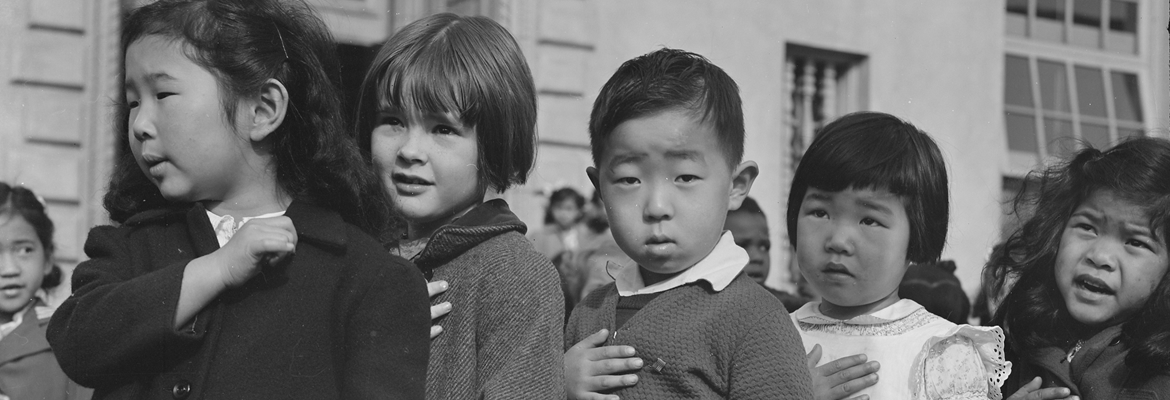June 29, 2015
The course draws upon Densho’s extensive digital archives, using historic photographs, documents, newspaper articles, political cartoons, films, and oral interviews to help teachers and students look beyond the most obvious answers and to think critically about social justice and civil rights.
Why do we think it’s important for educators to take this course and teach about this dark chapter in American history? Well, we have lots of reasons, but don’t take it from us. Here’s what teachers who have completed the course have to say about why they think think it’s essential curriculum to incorporate into the classroom:
1. Prevent history from repeating itself.
“It is important for students to learn that fear, racism, personal agendas, and mass hysteria can replace common sense, decency, and democratic ideals. They must understand that the incarceration of Japanese Americans was wrong, that racism is wrong. Students must understand that this sort of hysteria can occur again and they must do their part to make sure that it does not.”
“It’s important that students learn to think more critically when given facts about the incarceration. They should think in groups and alone about how he/she wants to fight for justice and speak “out loud” so that this part of our history is not repeated.”
2. It continues to shape our country and our communities.
“I teach in [name redacted] where there was a significant Japanese population before the war and there are still some Japanese Americans living in the area. I want my students to know the local history and how this issue pertains to their community. Furthermore, I want students to understand how unjust this was and what we can learn from this so it does not happen again.”
3. Nurture critical thinking, especially in times of fear and crisis.
“I think it’s important for students to understand how race prejudice, war hysteria, and failure of political leadership can lead to grave injustices that violate the laws we live by.”
“It’s important that they begin to realize news articles, the internet, etc., are not always factual. Using the thinking routines as a lifetime practice beyond the classroom would be an ultimate goal.”
4. Develop empathy and awareness about social injustices.
“It is an extremely important part of our history that is often untold and unspoken. My family was in Topaz and I have had to search for years for details of their experience. This history is also important because, as educators, we can connect it to present day events to assist our students in developing deeper understandings of injustice.”
“Teaching about the incarceration of Japanese Americans during WWII provides an opportunity to emphasize understanding of the terrible social injustices that have been inflicted upon others. Implementing it into the curriculum, we can create a thoughtful, deep awareness about our community, our world, and ourselves.”
5. Create socially responsible citizens.
“I think the students need to examine the writing and word choice of primary sources convincing the American citizens that the Japanese Americans posed a threat to the United States during World War II. They need to see the actual documents that did not recommend the internment of Japanese Americans–no military threat was posed by these people. People were following war hysteria. There was not trial or jury to these American citizens.”
“We can not judge a person based on physical characteristics or race. It is important to look for the facts and not let the opinions of a few cause us to forget those principles upon which our country was founded. Silence and secrecy need to be avoided. For too many years, this story was untold. It is an important part of our history.”
—
So there you have it. Teaching your students about what happened to Japanese Americans during WWII is important for understanding our nation’s past, and for helping to shape the citizens who will lead us into a more socially aware future.
Follow this link to learn about registering for the course and the generous incentives we’re offering to those who complete it.
If you agree that teaching Japanese American incarceration history is important, please help us spread the word about our new online course:
- Share this blog post on Facebook or Twitter.
- Print this flyer and put it in your school break room or some other place where teachers will see it: bit.ly/DenshoFlyer
- Encourage at least two other friends to take the course.
Thank you for your support and for your efforts to help us spread the word about Teaching WWII Japanese American Incarceration with Primary sources!
Additional details: This course is free for everyone and will require 5-6 hours of your time to complete. In addition to offering free content that can be applied toward Professional Development recertification, Densho is offering additional educational resources to the first 1,000 educators who complete the course. This includes two free DVDs–The Legacy of Heart Mountain and Conscience and the Constitution–as well as an educational supplement published in conjunction with The Seattle Times. Read more and register here.
